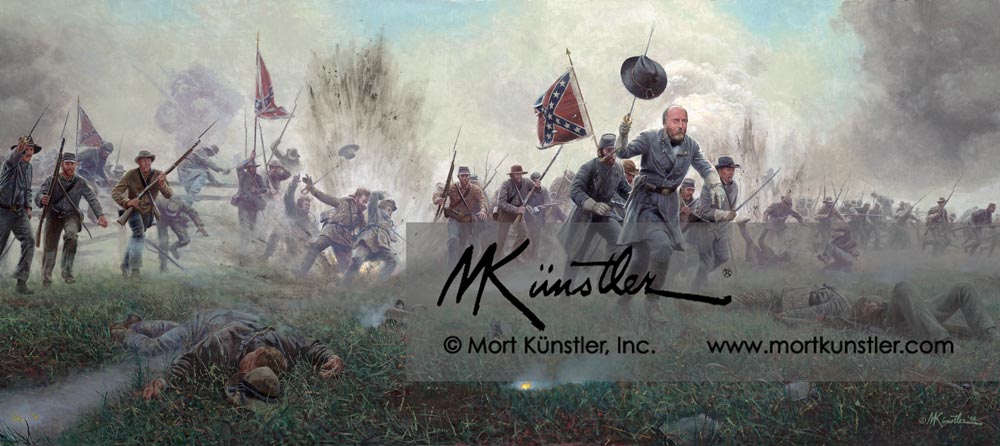The Official Mort Künstler Website
On They Came With Flags Flying - limited edition print
On They Came With Flags Flying - limited edition print
Pickett's Charge, Gettysburg, July 3, 1863
Couldn't load pickup availability
Custom framing is available for this print. Please call 800-850-1776 or email info@mortkunstler.com for more information.
LIMITED EDITION PRINTS
Paper Prints
Reproduction technique: Fine offset lithography on neutral pH archival quality paper using the finest fade-resistant inks.
Each giclée print is numbered and signed by the artist's daughter, Jane Künstler, and accompanied by a Certificate of Authenticity.
Image Size: 13-1/2” x 30” • Overall Size: 19-1/2” x 35”
Signed & Numbered • Edition Size: 950
Signed Artist’s Proof • Edition Size: 100
Giclée Canvas Prints
Reproduction technique: Giclées are printed with the finest archival pigmented inks on canvas.
Each print is numbered and signed by the artist and accompanied by a Certificate of Authenticity.
Size: 17” x 38”
Signed & Numbered • Edition Size: 100
Signed Artist’s Proof • Edition Size: 10
Historical Information:
They advanced under unfurled flags, crossing an open field under devastating fire. Their target was the center of the Federal line, which lay beneath a "copse of trees" atop distant Cemetery Ridge. For two days these men in butternut and gray – General Robert E. Lee's Army of Northern Virginia – had engaged in bloody combat with their blue-uniformed adversaries from the Federal Army of the Potomac. They had won a dramatic victory in the first day's fighting, but had failed to overwhelm either flank of the Federal army on the second day. On the third day, Lee launched the mightiest infantry assault of his career – 13,000 southern troops converging on the center of the Federal line. Surely, Lee believed, the line would break, the battle would go to the men in gray, and southern independence might finally be won.
The assault force appeared irresistible. "On they came with flags flying," a northern officer would later marvel. "In open sight of friend and foe, over the green valley, they marched in battle's stern array." Stout hearts, however, would not be enough for sons of the south this day. Their counterparts in blue were fighting on their home ground, and they held firm with a stubborn, valiant defense. Lee’s troops were flailed with a searing fire of shot, shell and canister, followed by scathing infantry fire. The formidable-looking formation was shattered, and among those left to carry the assault was a brigade of Virginians led by Brigadier General Lewis A. Armistead. Across the shot-torn field of fire they advanced, clambering over post-and-rail fences under a deadly hail, and charging up the slope of Cemetery Ridge. Armistead had come most of the way with hat boldly hoisted on his sword, marking the way for his men through the shroud of smoke and confusion of battle. The general and his troops would pierce the Federal line and capture a battery of artillery, only to be turned back by ranks of hard-fighting northern troops. Armistead would fall mortally wounded, and Gettysburg would prove to be the south’s “high-water mark.” For generations to come, Americans would remember the men of Pickett’s Charge, Armistead among them, as supreme examples of American valor.
Mort Künstler’s Comments:
Historian Shelby Foote once noted that for many southern boys it’s “always” 1 p.m. on July 3, 1863 and Pickett’s Charge has not yet begun. Lee’s troops are in place, hopes are high and the army seems invincible. That vision, the proud gray ranks of Lee’s army, eventually became more than just a southern tradition. Regardless of their region or allegiances, generations of Americans came to admire Pickett’s Charge – the most famous assault of the Civil War – as an expression of American determination and fortitude.
Center-stage in this panorama of American courage was Brigadier General Lewis A. Armistead and his brigade of Virginia troops. When those before him were shot down, Armistead kept going, with his hat held high on his sword for his men to see and follow. Armistead and his troops had to endure savage artillery fire across a mile of open fields and also scale a post-and-rail fence within easy range of Federal guns. It was both harrowing and heroic, and that’s what I’ve tried to convey in this painting. The historic elements are there – the assault route, the artillery fire, the post-and-rail fence, weapons, accoutrements, etc.
I paint in a realistic style, using a technique that conveys the full experience to the viewer, using light, colors, shadows, objects, motion, etc. That’s the point of art. The composition of this painting is like an inverted pyramid, arranged so that it draws the viewer’s attention to the central focus of the scene – General Armistead, his hat and flag. I believe this is the first major painting capturing Armistead at the Emmitsburg Road during Pickett’s Charge.
The courage of these southern soldiers was respected by their northern counterparts, and by generations of Americans from both the North and South. Who else but Americans – the people of the “melting pot” – would reunite after such a conflict and give each other mutual respect and affection.





